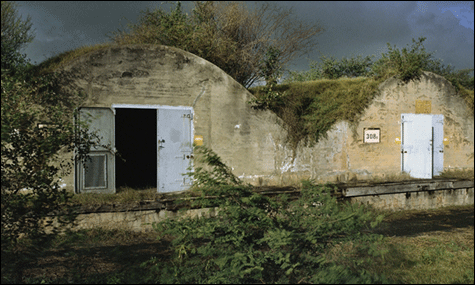Greta Pratt at Bernard Toale, Bonnie Donohue at the Center for Latino Arts
By GREG COOK | July 10, 2007

BUNKERS: The emotion of Bonnie Donohue’s photos of Vieques is outside the frame. |
Drive out of Boston, west along Route 2, and in the center of Massachusetts you pass souvenir shops decorated with giant teepees and a towering statue of an Indian in a feathered headdress. The iconography is all wrong — plains Indian instead of Northeastern woodland tribes — but in the 17th and 18th centuries, this region was one of the most fiercely contested territories between white English colonists and Native Americans.Turn south onto Route 5 and you wind up in Deerfield, one of the most forward incursions into native lands when the English began settling it in 1669. It suffered numerous raids as a result. The most famous occurred in 1704, when French, Mohawks, and Wobanakis killed 49 residents and kidnapped 110. At the Memorial Hall Museum sits a door from the Shelton house, one of the most stunning relics of that attack and the Massachusetts Indian wars as a whole. The planks in the center remain scarred from hatchet blows.
Greta Pratt traveled the country for several years visiting historic re-enactments, festivals, and roadside attractions. “I decided to photograph how Americans remember the past,” she has said, “in order to understand what is revealed by the events we choose to celebrate as history.” “Nineteen Lincolns” — her exhibit of color photos at Bernard Toale Gallery — explores the mental territory between relics like that door in Deerfield and tourist traps like those fake teepees along Route 2.
Pratt, who lives in upstate New York, is a connoisseur of historical faux pas. In one photo, a cleaning lady pushes a cart past a row of concrete teepee cottages, complete with air conditioners, at the Wigwam Motel in Holbrook, Arizona. This tourist trap is twice wrong — the native peoples of Arizona are famed for their pueblo masonry, not for wigwams, and the Wigwam Motel cottages are actually shaped like teepees. Some photos are jokes, like Pratt’s shot of Washington Crossing the Delaware, Washington Crossing,PA (1991), in which a Washington impersonator and a gang of guys in spiffy Revolutionary War–era uniforms stroll across a metal truss bridge. The capper is the sign: “Speed limit 15.” So it goes for George Washington’s amphibious 1776 Christmas-night raid that netted 900 Hessian mercenaries at a cost of four Americans injured.
Pratt’s title piece, portraits of 19 different Abraham Lincoln impersonators in 2005, will be familiar to those who saw the “Ahistoric Occasion” exhibit at Mass MoCA in North Adams last year; it nods toward questions of authenticity but is mostly a thin goof. Most interesting here and in Pratt’s 2005 book Using History are images in which she scratches at places where thorny radical politics and revolutionary movements get smoothed over and polished into wholesome entertainments and product merchandising.One image in the book shows an African-American waiter in a suit arriving for work at a 1996 “Confederate Ball” in Virginia. He stops in his station wagon to talk to a white guy dressed in the gray military uniform of the Confederacy. In this mundane interaction between real and re-enactment, the sordid slave-holding heart of genteel Confederate society — the unpleasantness one represses if one is organizing a Confederate ball — flashes before your eyes big and mean and ugly. And “Nineteen Lincolns” includes a photo of an African-American couple dressed up as Black Panthers, with a toy-bullet bandolier and fists raised in the black-power salute, at a polite 1997 masquerade ball in Baltimore.
 Topics
Topics:
Museum And Gallery
, Culture and Lifestyle, George Washington, Etiquette and Manners, More  , Culture and Lifestyle, George Washington, Etiquette and Manners, Travel and Tourism, Abraham Lincoln, Greta Pratt, Center for Latino Arts, U.S. Department of the Interior, Less
, Culture and Lifestyle, George Washington, Etiquette and Manners, Travel and Tourism, Abraham Lincoln, Greta Pratt, Center for Latino Arts, U.S. Department of the Interior, Less 